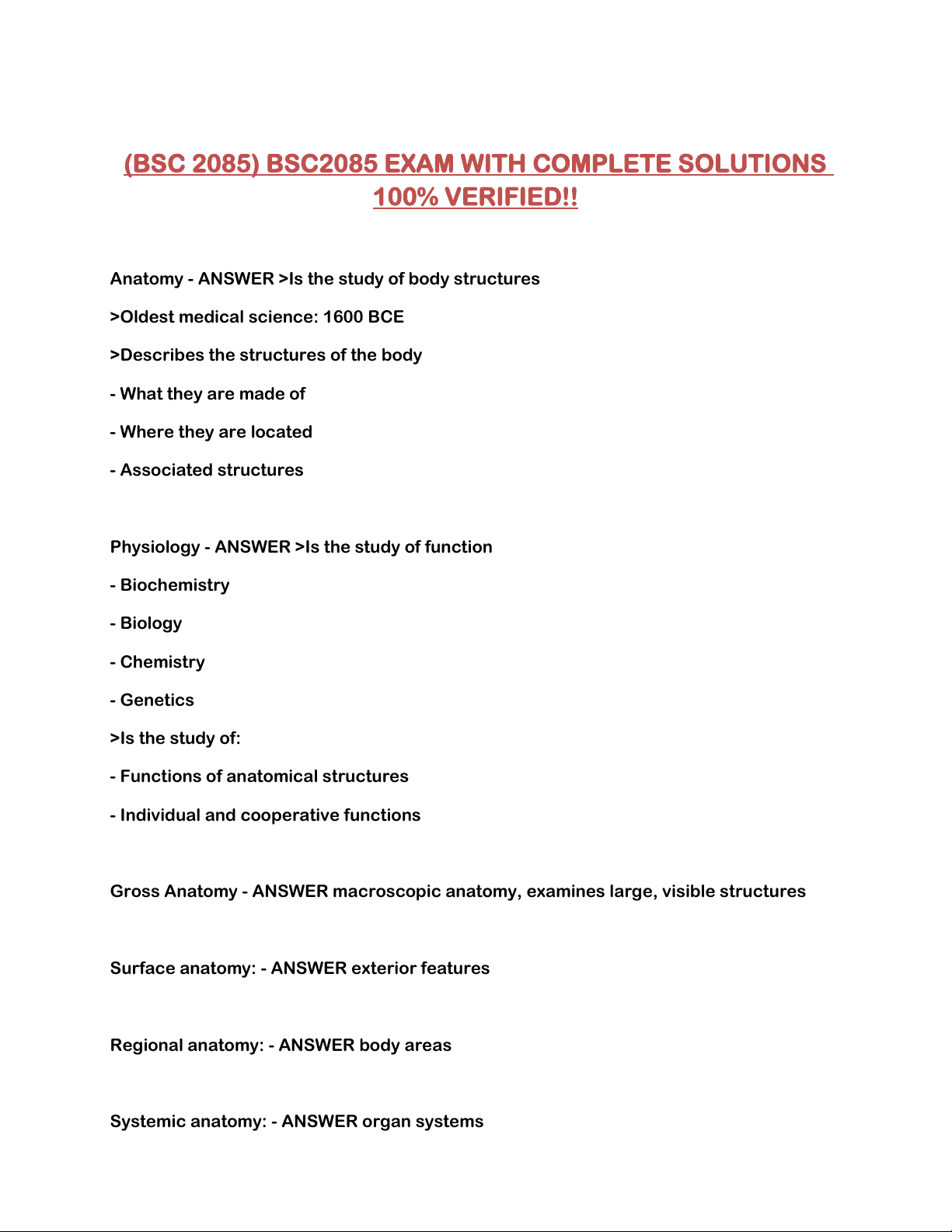
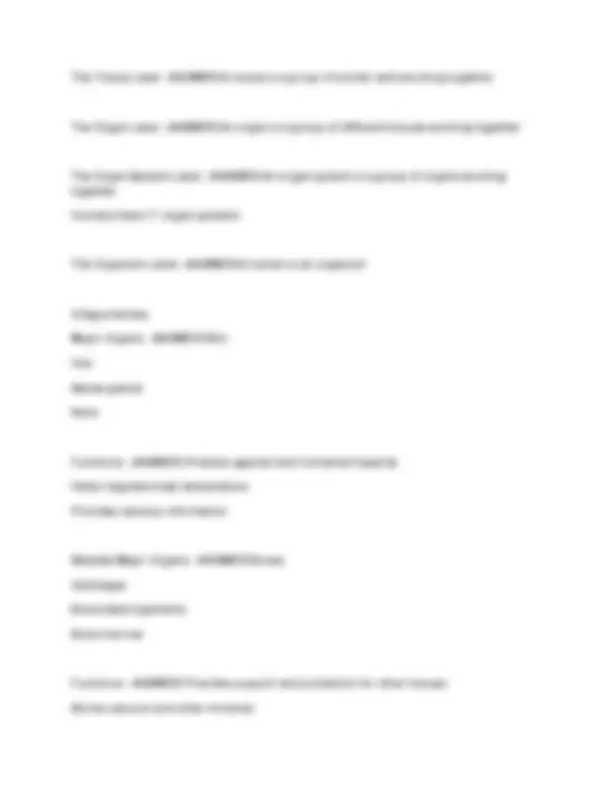
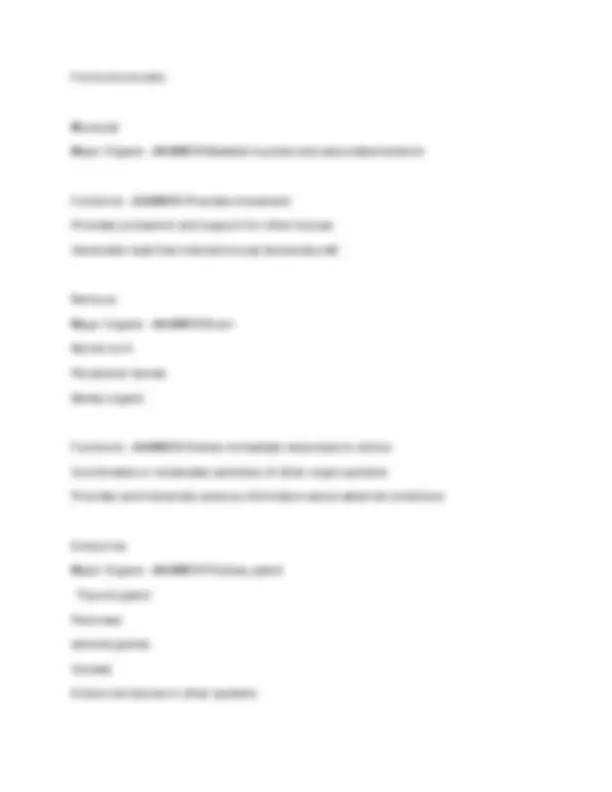
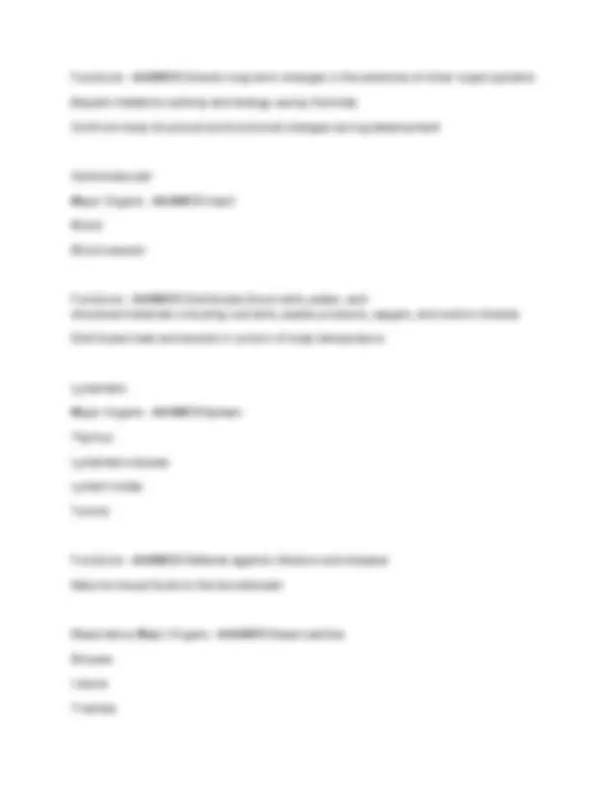
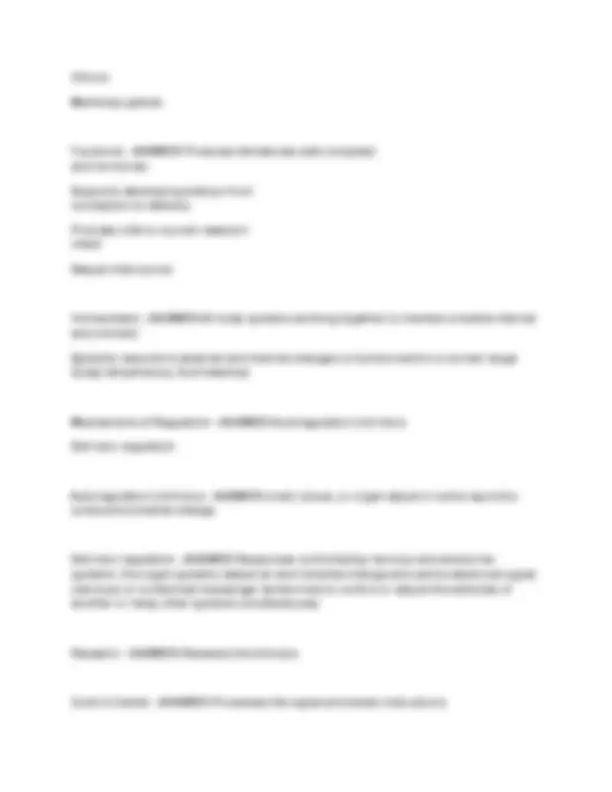
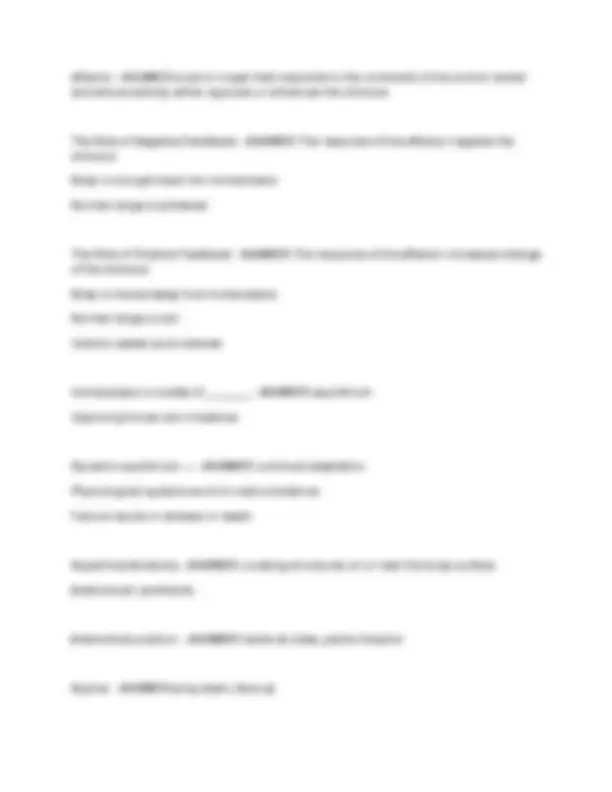

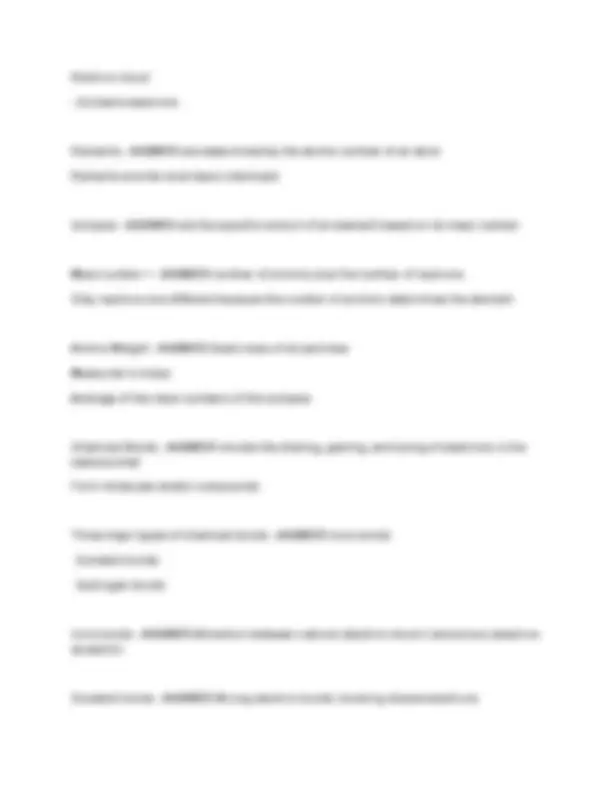
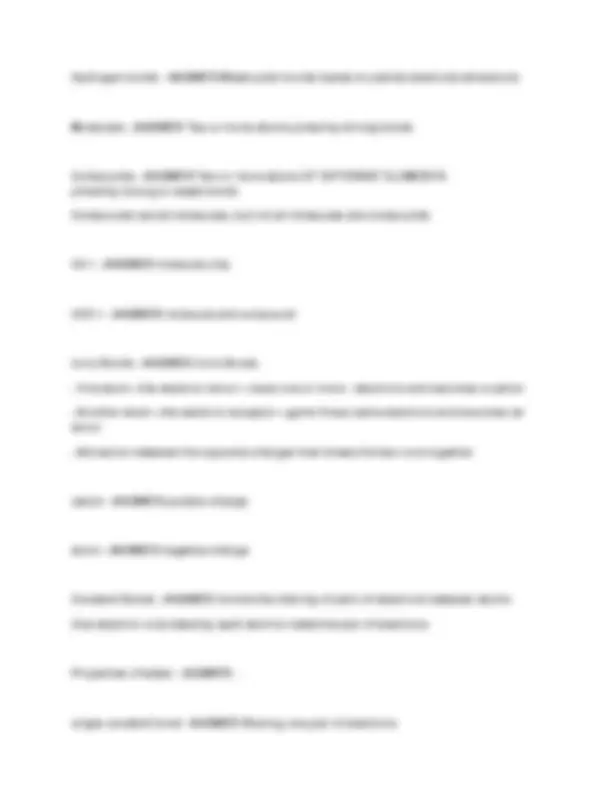
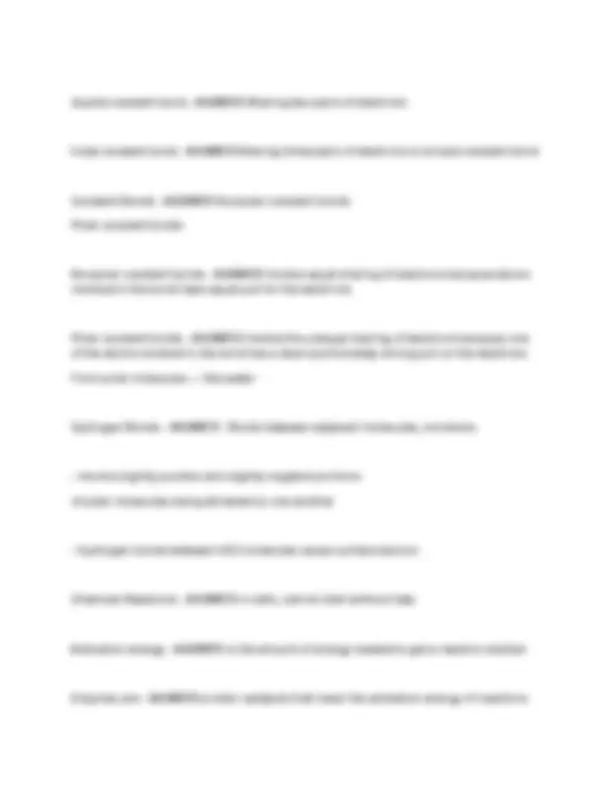
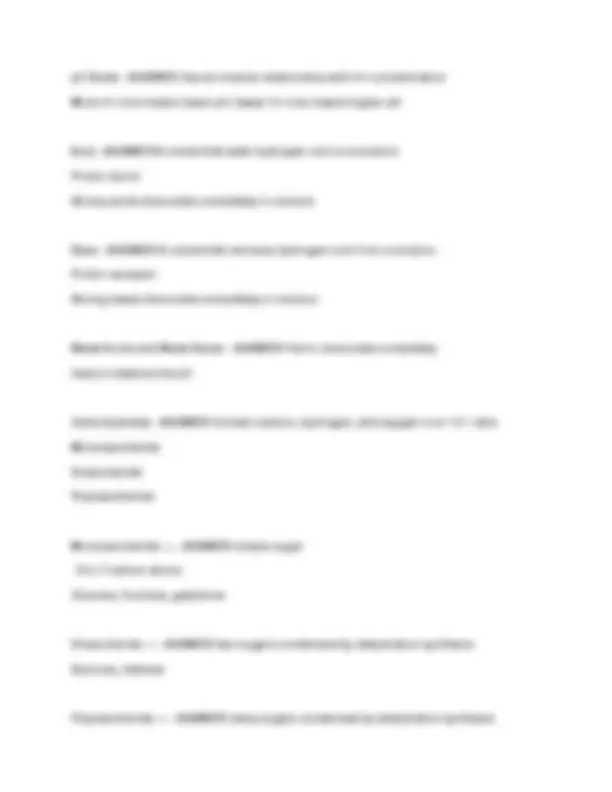
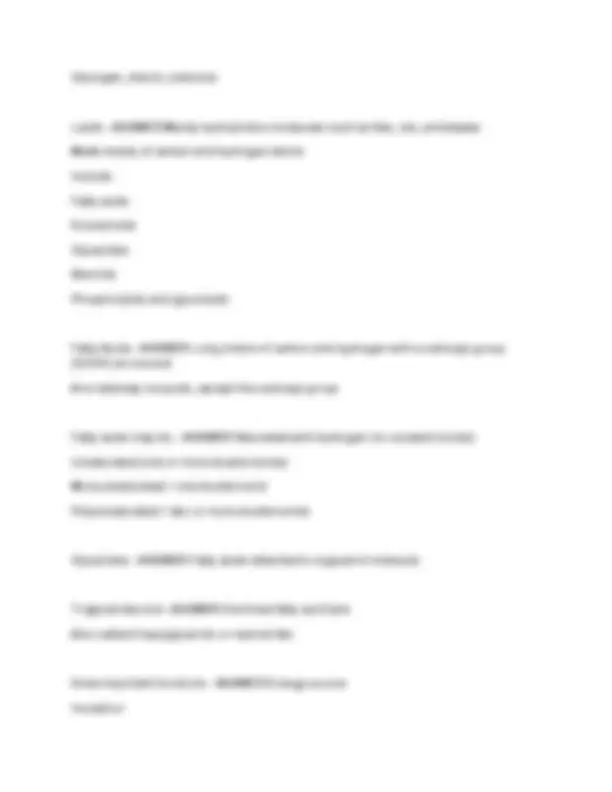
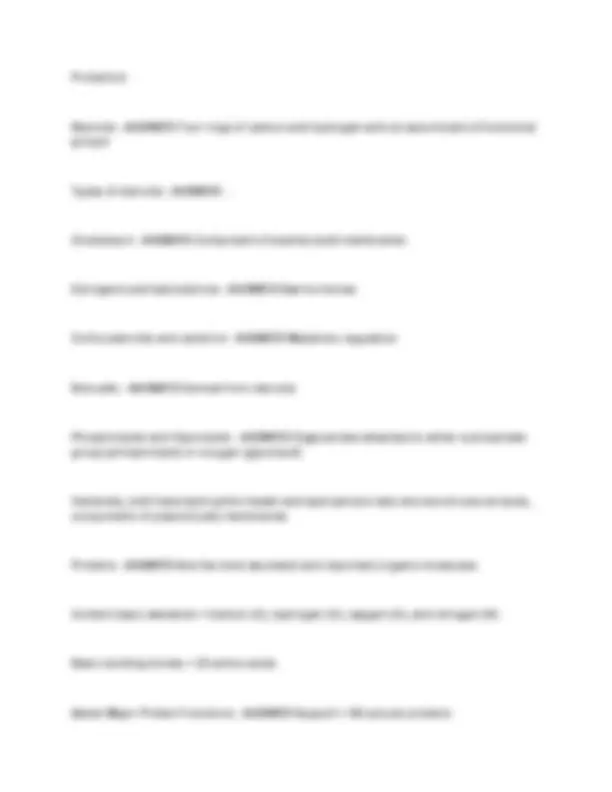
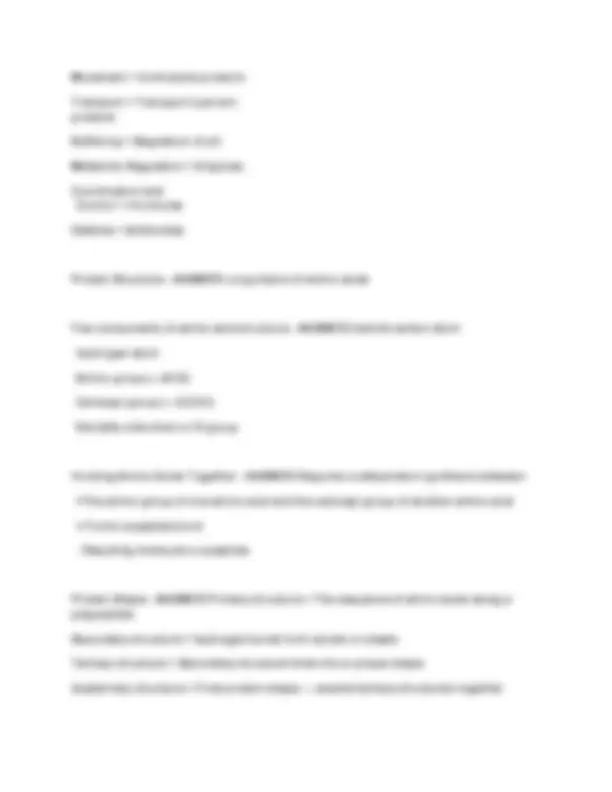
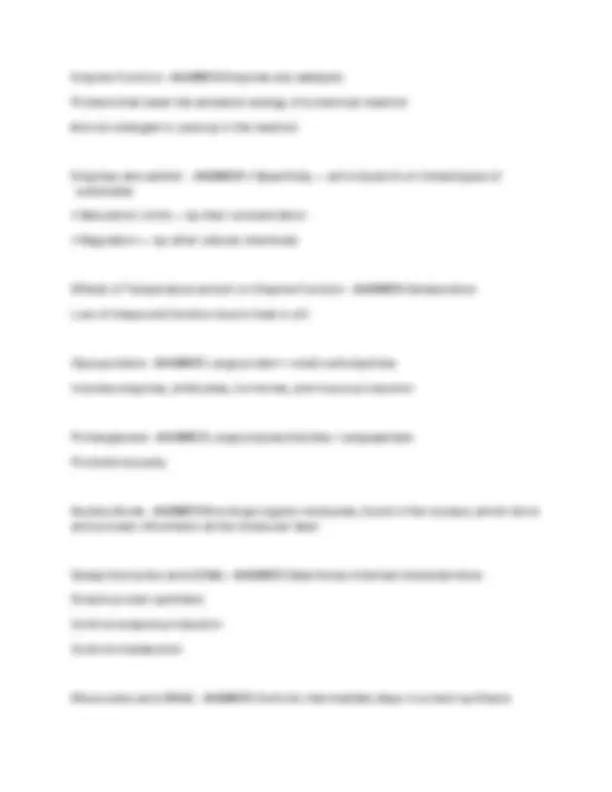
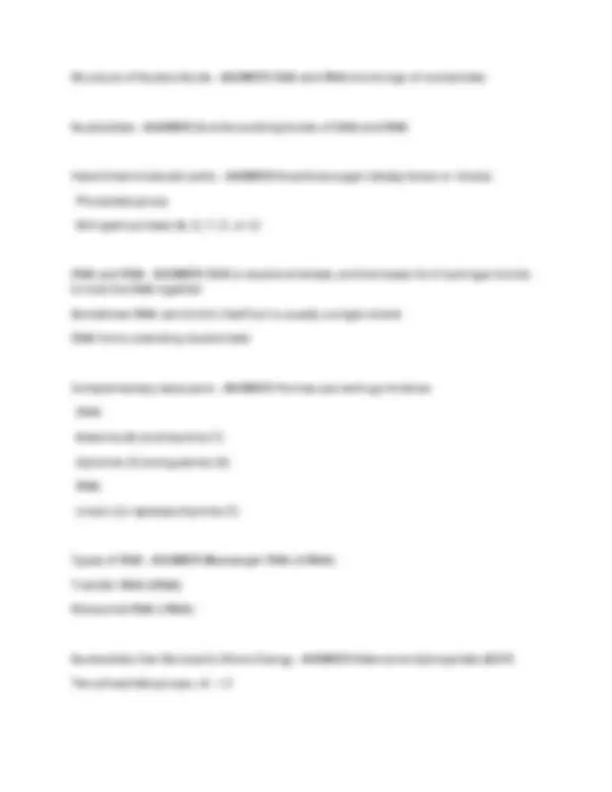
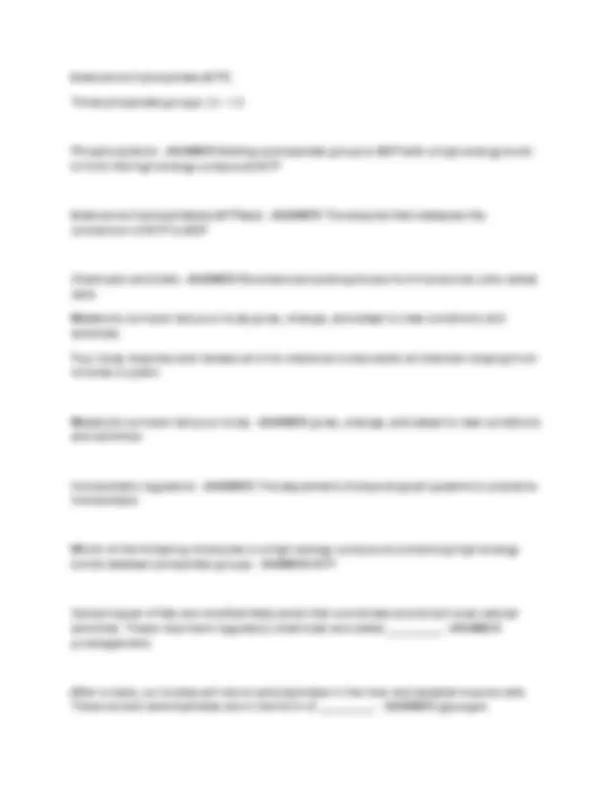
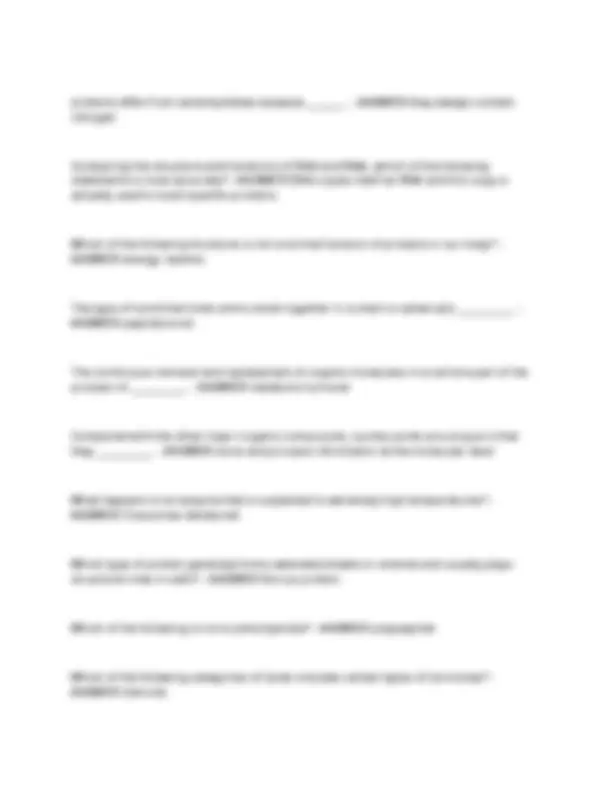
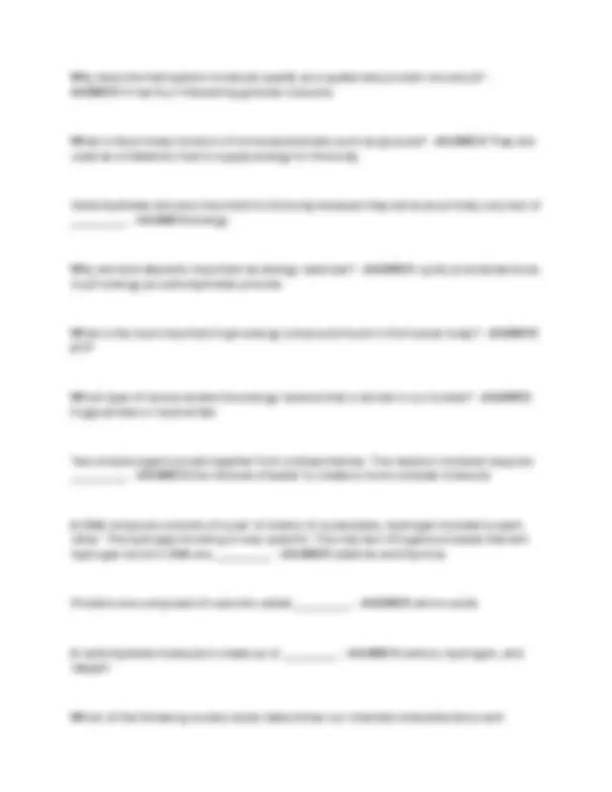
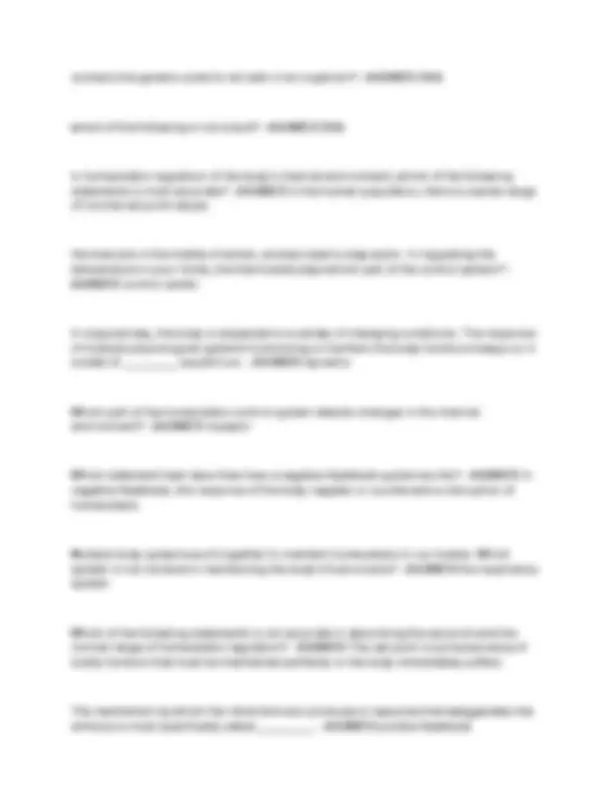
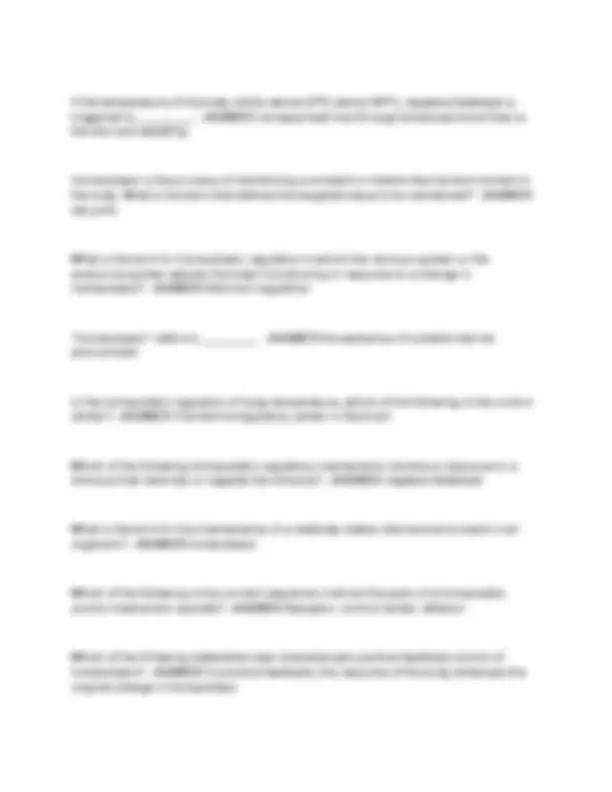
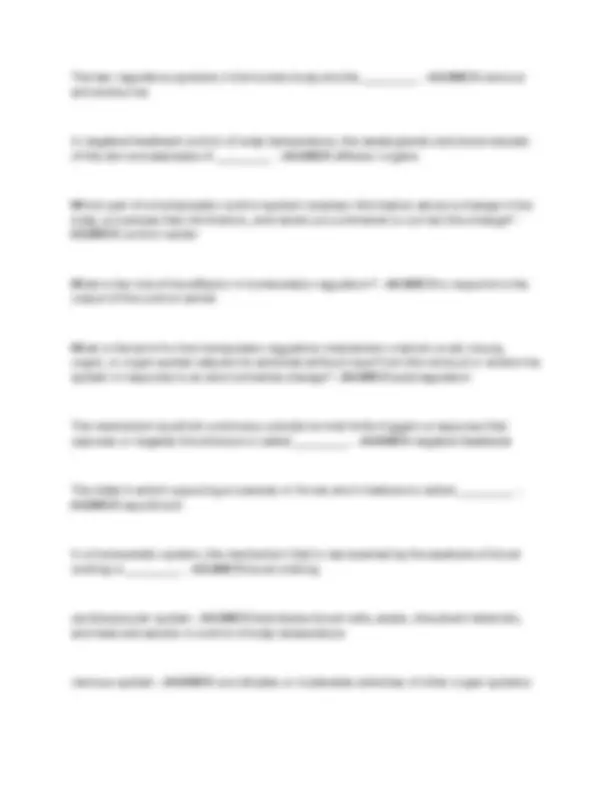



Study with the several resources on Docsity

Earn points by helping other students or get them with a premium plan


Prepare for your exams
Study with the several resources on Docsity

Earn points to download
Earn points by helping other students or get them with a premium plan
Community
Ask the community for help and clear up your study doubts
Discover the best universities in your country according to Docsity users
Free resources
Download our free guides on studying techniques, anxiety management strategies, and thesis advice from Docsity tutors
(BSC 2085) BSC2085 EXAM WITH COMPLETE SOLUTIONS 100% VERIFIED!!
Typology: Exams
1 / 30

This page cannot be seen from the preview
Don't miss anything!























Anatomy - ANSWER >Is the study of body structures
Oldest medical science: 1600 BCE Describes the structures of the body
Physiology - ANSWER >Is the study of function
Is the study of:
Gross Anatomy - ANSWER macroscopic anatomy, examines large, visible structures
Surface anatomy: - ANSWER exterior features
Regional anatomy: - ANSWER body areas
Systemic anatomy: - ANSWER organ systems
Clinical anatomy: - ANSWER medical specialties
Developmental anatomy - ANSWER from conception to death
Microscopic anatomy - ANSWER examines cells and molecules
Cytology: cyt- = - ANSWER study of cells and their structures cyt- = cell
Histology: - ANSWER study of tissues and their structures
Cell physiology: - ANSWER processes within and between cells
Organ physiology: - ANSWER functions of specific organs
Systemic physiology: - ANSWER functions of an organ system
Pathological physiology: - ANSWER effects of diseases
The Chemical (or Molecular) Level - ANSWER Atoms are the smallest chemical units Molecules are a group of atoms working together
The Cellular Level - ANSWER Cells are a group of atoms, molecules, and organelles working together
Forms blood cells
Muscular Major Organs - ANSWER Skeletal muscles and associated tendons
Functions - ANSWER Provides movement Provides protection and support for other tissues Generates heat that maintains body temperatureS
Nervous Major Organs - ANSWER Brain Spinal cord Peripheral nerves Sense organs
Functions - ANSWER Directs immediate responses to stimuli Coordinates or moderates activities of other organ systems Provides and interprets sensory information about external conditions
Endocrine Major Organs - ANSWER Pituitary gland Thyroid gland Pancreas adrenal glands Gonads Endocrine tissues in other systems
Functions - ANSWER Directs long-term changes in the activities of other organ systems Adjusts metabolic activity and energy use by the body Controls many structural and functional changes during development
Cardiovascular Major Organs - ANSWER Heart Blood Blood vessels
Functions - ANSWER Distributes blood cells, water, and dissolved materials including nutrients, waste products, oxygen, and carbon dioxide Distributes heat and assists in control of body temperature
Lymphatic Major Organs - ANSWER Spleen Thymus Lymphatic vessels Lymph nodes Tonsils
Functions - ANSWER Defends against infection and disease Returns tissue fluids to the bloodstream
Respiratory Major Organs - ANSWER Nasal cavities Sinuses Larynx Trachea
Urinary Major Organs - ANSWER Kidneys Ureters Urinary bladder Urethra
Functions - ANSWER Excretes waste products from the blood Controls water balance by regulating volume of urine produced Stores urine prior to voluntary elimination Regulates blood ion concentrations and pH
Male Reproductive Major Organs - ANSWER Testes Epididymides Ductus deferentia Seminal vesicles Prostate gland Penis Scrotum
Functions - ANSWER Produces male sex cells (sperm), seminal fluids, and hormones Sexual intercourse
Female Reproductive Major Organs - ANSWER Ovaries Uterine tubes Uterus Vagina Labia
Clitoris Mammary glands
Functions - ANSWER Produces female sex cells (oocytes) and hormones Supports developing embryo from conception to delivery Provides milk to nourish newborn infant Sexual intercourse
Homeostasis - ANSWER All body systems working together to maintain a stable internal environment Systems respond to external and internal changes to function within a normal range (body temperature, fluid balance)
Mechanisms of Regulation - ANSWER Autoregulation (intrinsic) Extrinsic regulation
Autoregulation (intrinsic) - ANSWER a cell, tissue, or organ adjust in some repond to some envriomental change
Extrinsic regulation - ANSWER Responses controlled by nervous and endocrine systems; the organ systems detect an enviromental change and send a electrical signal (nervous) or a chemical messenger (endocrine) to control or adjust the activities of another or many other systems simultaneously
Receptor - ANSWER Receives the stimulus
Control Center - ANSWER Processes the signal and sends instructions
Prone: - ANSWER lying down, face down
Sectional Anatomy - ANSWER Planes and sections
Plane: - ANSWER a three-dimensional axis
Section: - ANSWER a slice parallel to a plane Used to visualize internal organization and structure Important in radiological techniques MRI PET CT
Essential Functions of Body Cavities - ANSWER Protect organs from accidental shocks Permit changes in size and shape of internal organs
Ventral Body Cavity (Coelom) - ANSWER Divided by the diaphragm Thoracic cavity Abdominopelvic cavity
Serous Membranes - ANSWER Line body cavities and cover organs Consist of parietal layer and visceral layer
Parietal layer — - ANSWER lines cavity
Visceral layer - ANSWER covers organ
The Thoracic Cavity - ANSWER Right and left pleural cavities Contain right and left lungs Mediastinum
Mediastinum - ANSWER Upper portion filled with blood vessels, trachea, esophagus, and thymus Lower portion contains pericardial cavity
The Abdominopelvic Cavity - ANSWER Peritoneal cavity: chamber within abdominopelvic cavity
Abdominal cavity — - ANSWER superior portion Diaphragm to top of pelvic bones Contains digestive organs Retroperitoneal space Area posterior to peritoneum and anterior to muscular body wall Contains pancreas, kidneys, ureters, and parts of the digestive tract
Retroperitoneal space - ANSWER Area posterior to peritoneum and anterior to muscular body wall Contains pancreas, kidneys, ureters, and parts of the digestive tract
Electron cloud
Elements - ANSWER are determined by the atomic number of an atom Elements are the most basic chemicals
Isotopes - ANSWER are the specific version of an element based on its mass number
Mass number = - ANSWER number of protons plus the number of neutrons Only neutrons are different because the number of protons determines the element
Atomic Weight - ANSWER Exact mass of all particles Measured in moles Average of the mass numbers of the isotopes
Chemical Bonds - ANSWER Involve the sharing, gaining, and losing of electrons in the valence shell Form molecules and/or compounds
Three major types of chemical bonds - ANSWER Ionic bonds Covalent bonds Hydrogen bonds
Ionic bonds - ANSWER Attraction between cations (electron donor) and anions (electron acceptor)
Covalent bonds - ANSWER Strong electron bonds involving shared electrons
Hydrogen bonds - ANSWER Weak polar bonds based on partial electrical attractions
Molecules - ANSWER Two or more atoms joined by strong bonds
Compounds - ANSWER Two or more atoms OF DIFFERENT ELEMENTS joined by strong or weak bonds Compounds are all molecules, but not all molecules are compounds
H2 = - ANSWER molecule only
H2O = - ANSWER molecule and compound
Ionic Bonds - ANSWER Ionic Bonds
cation - ANSWER positive charge
anion - ANSWER negative charge
Covalent Bonds - ANSWER Involve the sharing of pairs of electrons between atoms One electron is donated by each atom to make the pair of electrons
Properties of water - ANSWER ...
single covalent bond - ANSWER Sharing one pair of electrons
Nutrients - ANSWER Essential molecules obtained from food
Metabolites - ANSWER Molecules made or broken down in the body
Inorganic Compounds - ANSWER Molecules not based on carbon and hydrogen Carbon dioxide, oxygen, water, and inorganic acids, bases, and salts
Organic Compounds - ANSWER Molecules based on carbon and hydrogen Carbohydrates, proteins, lipids, and nucleic acids
Water - ANSWER Accounts for up to two-thirds of your total body weight
A solution is a - ANSWER uniform mixture of two or more substances It consists of a solvent, or medium, in which atoms, ions, or molecules of another substance, called a solute, are individually dispersed
properties of water - ANSWER ...
Solubility - ANSWER Water's ability to dissolve a solute in a solvent to make a solution
Reactivity - ANSWER Most body chemistry occurs in water
Lubrication - ANSWER To moisten and reduce friction
High Heat Capacity - ANSWER Water's ability to absorb and retain heat
The Properties of Aqueous Solutions - ANSWER Electrolytes and body fluids
Electrolytes - ANSWER are inorganic ions that conduct electricity in solution
Hydrophilic - ANSWER hydro- = water, philos = loving Interacts with water Includes ions and polar molecules
Hydrophobic - ANSWER phobos = fear Does NOT interact with water Includes nonpolar molecules, fats, and oils
pH - ANSWER The concentration of hydrogen ions (H+) in a solution
Neutral pH - ANSWER A balance of H+ and OH Pure water = 7.
Acidic pH - ANSWER Lower Than 7. High H+ concentration Low OH concentration
Basic (or alkaline) pH - ANSWER Higher Than 7. Low H+ concentration High OH concentration
pH of Human Blood - ANSWER Ranges from 7.35 to 7.
Glycogen, starch, cellulose
Lipids - ANSWER Mainly hydrophobic molecules such as fats, oils, and waxes Made mostly of carbon and hydrogen atoms Include: Fatty acids Eicosanoids Glycerides Steroids Phospholipids and glycolipids
Fatty Acids - ANSWER Long chains of carbon and hydrogen with a carboxyl group (COOH) at one end Are relatively nonpolar, except the carboxyl group
Fatty acids may be: - ANSWER Saturated with hydrogen (no covalent bonds) Unsaturated (one or more double bonds) Monounsaturated = one double bond Polyunsaturated = two or more double bonds
Glycerides - ANSWER Fatty acids attached to a glycerol molecule
Triglycerides are - ANSWER the three fatty-acid tails Also called triacylglycerols or neutral fats
three important functions - ANSWER Energy source Insulation
Protection
Steroids - ANSWER Four rings of carbon and hydrogen with an assortment of functional groups
Types of steroids - ANSWER ...
Cholesterol - ANSWER Component of plasma (cell) membranes
Estrogens and testosterone - ANSWER Sex hormones
Corticosteroids and calcitriol - ANSWER Metabolic regulation
Bile salts - ANSWER Derived from steroids
Phospholipids and Glycolipids - ANSWER Diglycerides attached to either a phosphate group (phospholipid) or a sugar (glycolipid)
Generally, both have hydrophilic heads and hydrophobic tails and are structural lipids, components of plasma (cell) membranes
Proteins - ANSWER Are the most abundant and important organic molecules
Contain basic elements = Carbon (C), hydrogen (H), oxygen (O), and nitrogen (N)
Basic building blocks = 20 amino acids
Seven Major Protein Functions - ANSWER Support = Structural proteins